
Pivoting to digital maturity Seven capabilities central to digital transformation
19 minute read
14 March 2019
Why do digital transformation efforts sometimes fail to deliver? Applying seven “digital pivots” across the enterprise can help organizations reap the benefits of increasing digital maturity.
Executive summary
Constant pressure on businesses to innovate and grow in a dynamic competitive environment has made digital transformation a top priority for businesses across industries. Organizations are devoting significant time, effort, and capital to digitally transform. Some achieve significant tangible results from these efforts. Others achieve less impact. Why?
Learn more
Explore the Digital transformation collection
Subscribe to receive related content
This article is featured in Deloitte Review, issue 25
Download the issue
Download the Deloitte Insights and Dow Jones app
In search of the factors that lead to digital transformation success, we surveyed 1,200 senior executives knowledgeable about their organizations’ digital transformation efforts. The findings from the survey, coupled with our own experience, show how organizations can structure their digital transformation initiatives to help ensure that they have a positive impact—in other words, that they’re doing what it takes to become more digitally mature.
In the pages of this report, we discuss in detail our findings on what tends to drive successful digital transformation. These can be briefly summarized as follows:
- Organizations are planning to invest aggressively in digital transformation efforts. According to our survey, digital transformation budgets will increase by 25 percent in the coming year versus the prior year.
- Digital transformation is about more than implementing discrete technologies. Rather, it requires developing a broad array of technology-related assets and business capabilities, which we call digital pivots, that can help propel an organization along the journey toward becoming a digital enterprise.
- Organizations that are more digitally mature—meaning they are deriving greater benefit from digital transformation efforts—are in large part distinguished by their cross-functional execution of more digital pivots. In other words, the more comprehensive and coordinated an organization’s digital transformation efforts are, the more likely it is to be digitally mature.
- On average, higher-maturity organizations’ digital transformation efforts are twice as broad as those at lower-maturity organizations.
- To prioritize transformation efforts, we recommend first implementing foundational pivots focused on assets such as infrastructure and talent, then applying a broad range of pivots to one business function to achieve systemic, pervasive transformation of that function. Focusing on transforming back-office operational functions first is less risky, whereas focusing on customer-facing functions may produce market impact more quickly.
- The digital pivots are necessary—but not sufficient—for digital transformation. Higher-maturity organizations tend to be distinguished by the presence of complementary “soft” factors such as strong leadership and a digital mindset.
- A higher level of digital maturity is correlated with above-average financial performance. Higher-maturity organizations are nearly three times more likely than lower-maturity organizations to report net profit margins and annual revenue growth that are significantly above the averages in their industry.1
Executing digital transformation
Digital transformation has risen to the top of organizational agendas. In a recent survey of US and European business and technology decision-makers, some three-quarters said their company had undertaken a digital initiative.2 But effort does not necessarily translate into benefit, and many organizations continue to struggle to translate the execution of digital transformation programs into tangible impact.
It must be noted that there is disagreement on what digital transformation means. For our purposes, digital transformation is about becoming a digital enterprise: an organization that uses data and technology to continuously evolve all aspects of its business models—what it offers, how it sells (interacts with its customers) and delivers, and how it operates.
The digital pivots
Our experience tells us that becoming a digital enterprise requires the development of a broad array of assets and capabilities, which we call digital pivots, enumerated in figure 1.
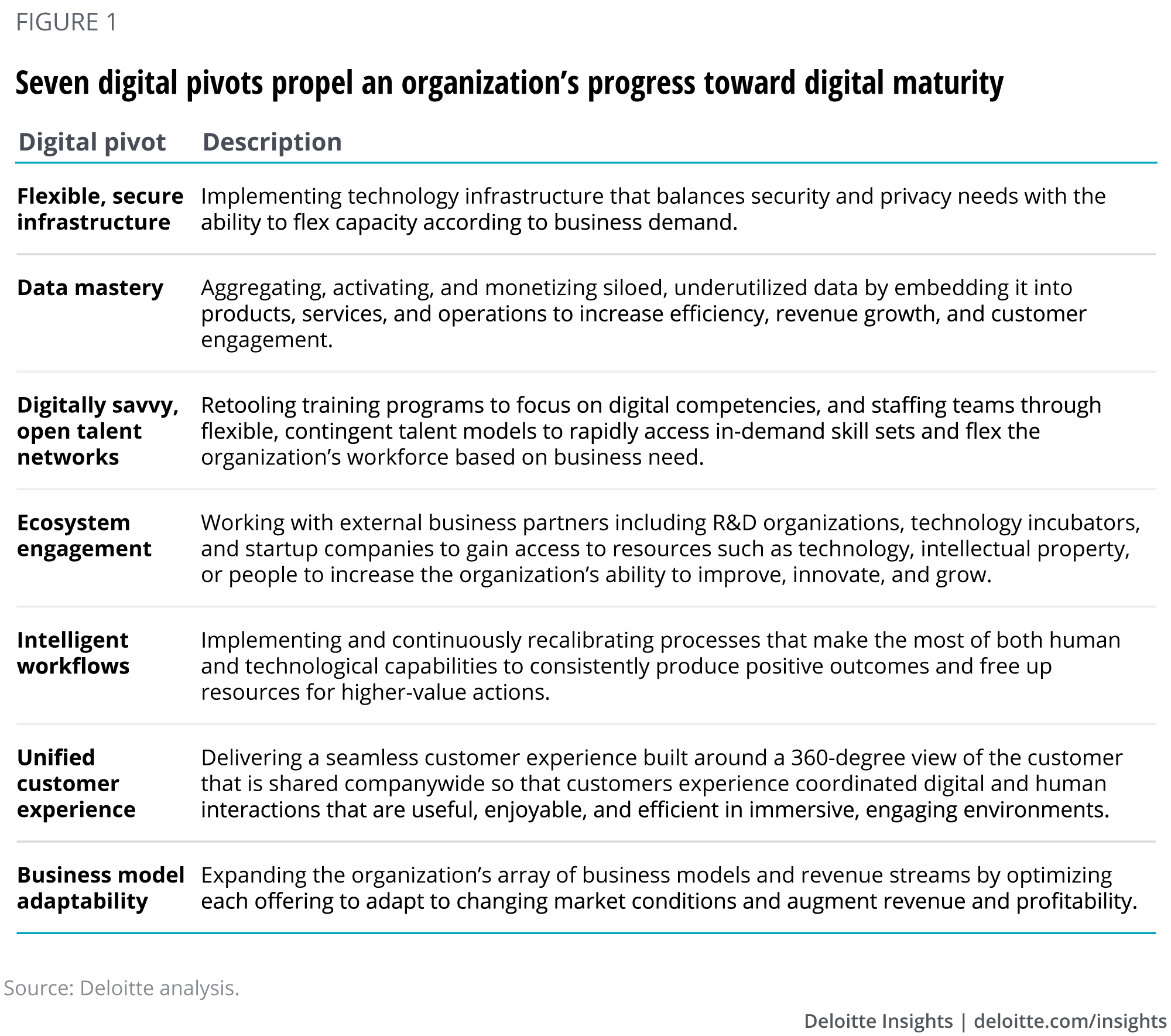
We have learned—and will show in this report—that the digital pivots have greater impact when executed in concert rather than selectively. And the greatest benefit comes to organizations that apply them widely—across multiple business functions.3
Increasing the impact of digital transformation
To better understand the digital pivots’ role in driving digital maturity, we surveyed senior executives at medium- sized and large organizations in the United States who were knowledgeable about the digital transformation efforts underway across their organizations. The survey asked respondents to indicate which pivots their organization had executed and how broadly the pivots were applied across business functions such as IT, marketing, sales, finance, and so on. We also asked how much benefit, if any, those pivots had delivered. (For details on the survey methodology, see Appendix A: Methodology and demographics.)
Digital maturity is measured in business benefit
Transformation initiatives are only as valuable as the business impact they drive. In our analysis of the survey results, therefore, we adopted a simple measure of digital maturity: the extent to which respondents said an organization’s digital transformation efforts are delivering business benefit. We then classified respondents into three segments—lower, median, and higher—according to the degree of business benefit they said they were achieving from their actions (figure 2). Digital transformation is a continual process, and digital maturity is a moving target. So we present these as relative rather than absolute classifications.
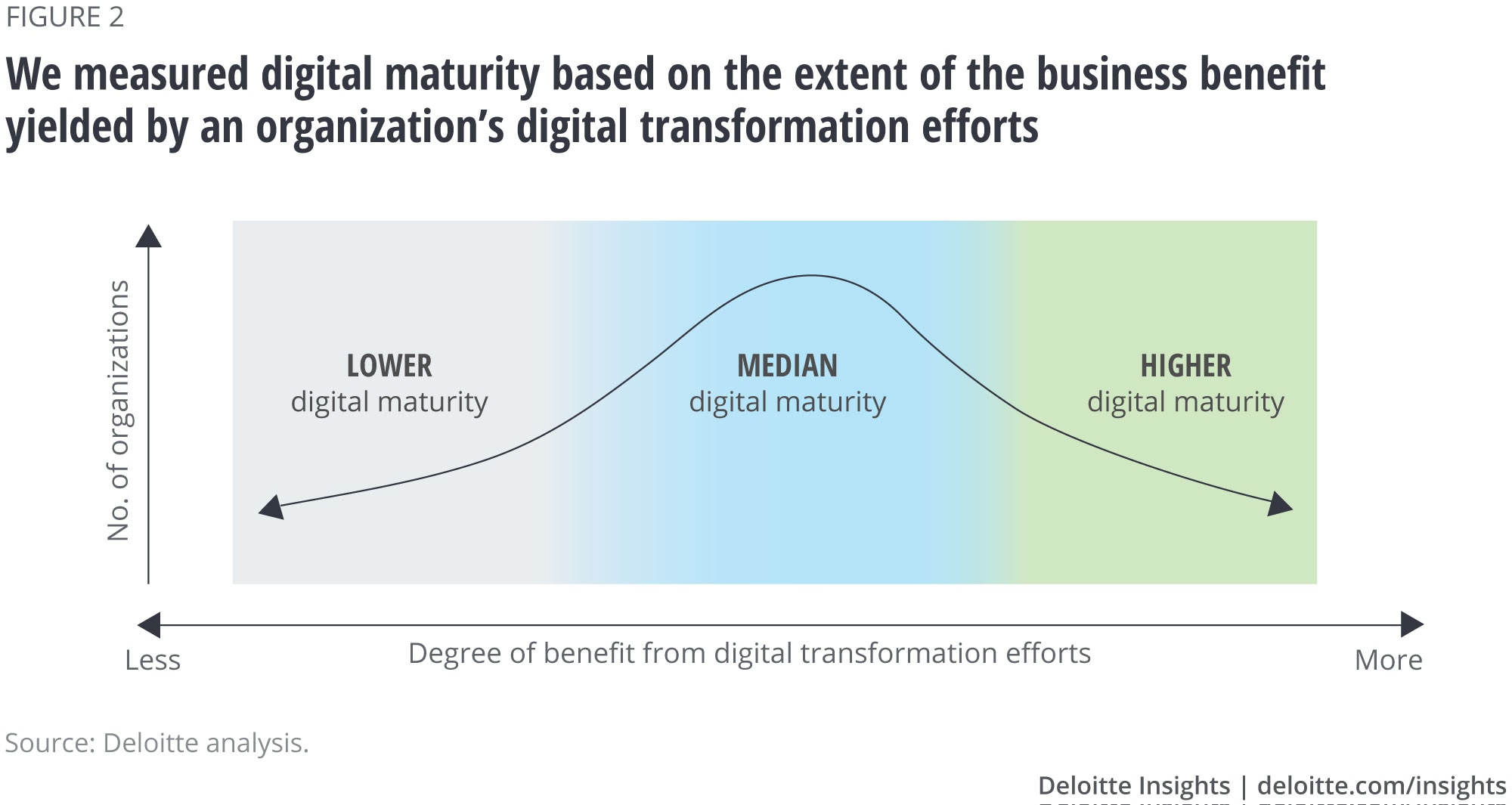
The data we collected and analyzed in this survey, in addition to our experience helping our clients navigate their digital transformation journey, has helped us isolate some of the key factors that drive successful digital transformation. While no single prescription applies to every company, these insights can be used to guide the design and implementation of digital transformation programs that deliver tangible results.
Digital maturity increases as pivots are applied in more business functions
Digital maturity is correlated with how systematically and how broadly an organization executes the digital pivots. In other words, the more widely these assets and capabilities are implemented and adopted in an organization, the more likely the organization will experience significant positive business impact from them (figure 3).
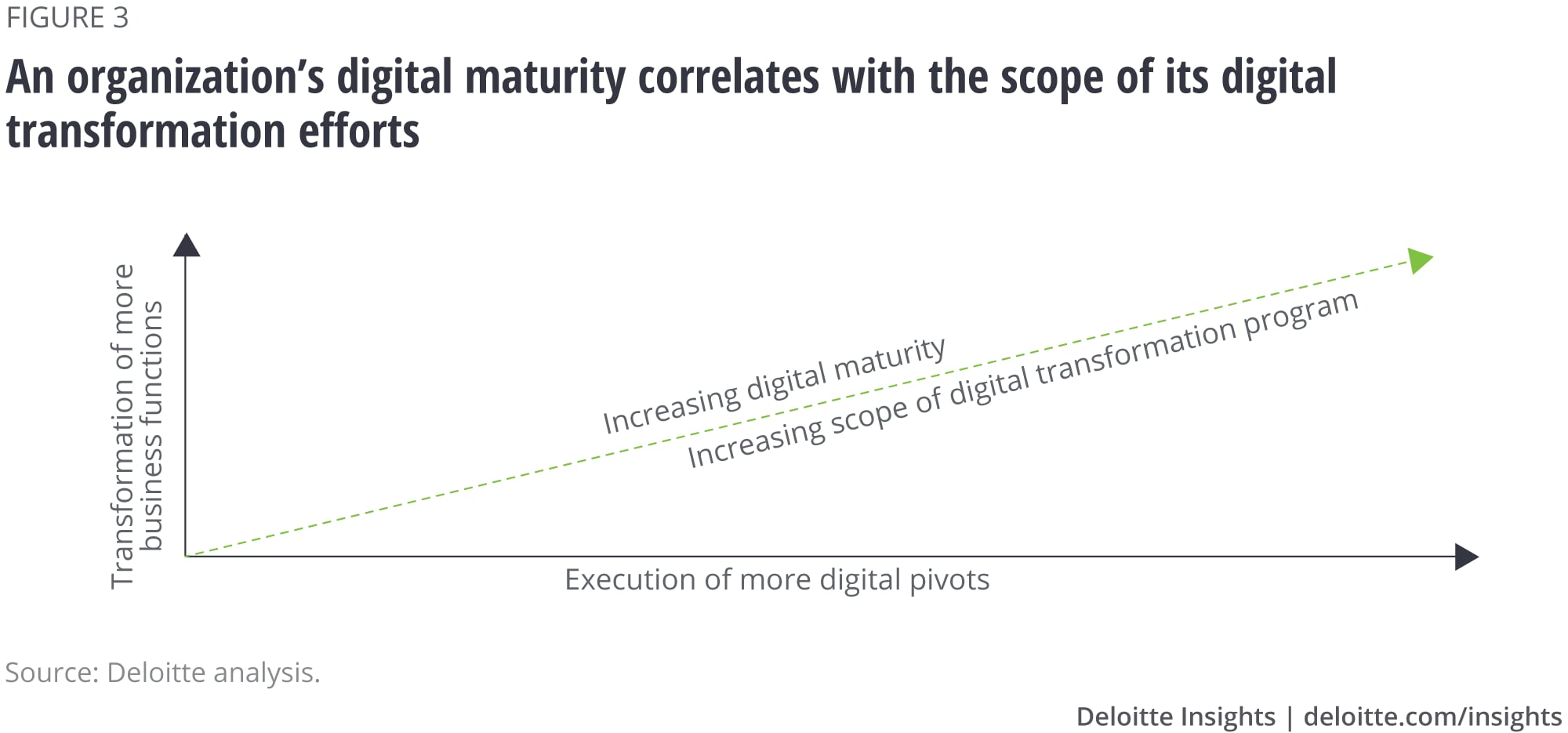
Lower-maturity companies tend to think of digital transformation in narrow terms—for instance, as simply supporting omnichannel customer interaction or investing in robotic process automation for call centers. Higher-maturity companies tend to have a more expansive view.
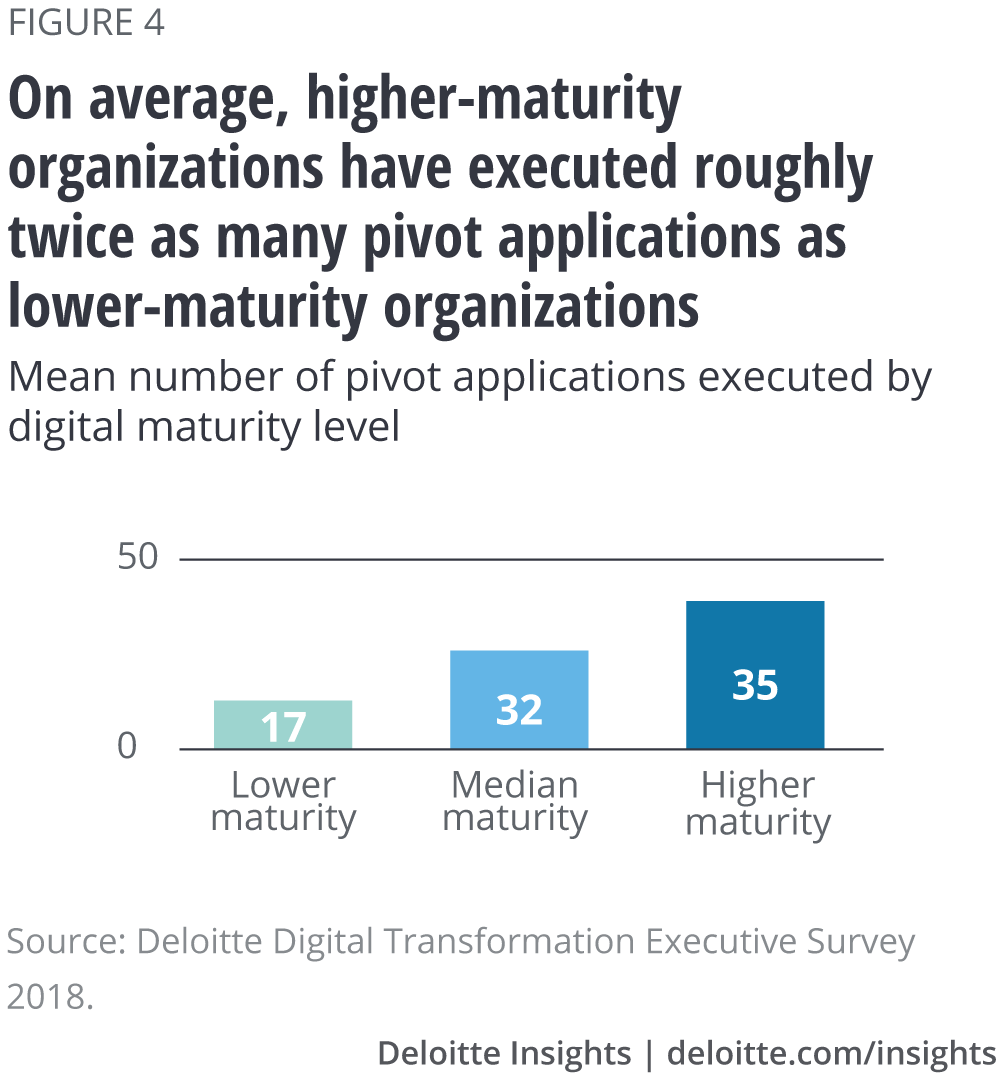
Our survey found that higher-maturity organizations’ digital transformation efforts tend to be twice as broad as those of lower-maturity organizations, on average.4 Having asked participants to select in which of nine business functions any of seven digital pivots were being applied, we could identify which of the 63 possible pivot applications—that is, efforts to apply a pivot to a specific function—each organization was executing. Lower-maturity organizations executed an average of 17 pivot applications, whereas higher-maturity organizations executed an average of 35 (see figure 4). What’s more, all higher-maturity respondents had executed all seven of the pivots in at least some functions. This validates our belief that maximizing the benefits of digital transformation requires a concerted effort to execute the digital pivots, applying them broadly across an organization.
Prioritizing digital transformation efforts
Digital transformation requires a comprehensive, concerted effort. But organizations must start somewhere.
Begin with the foundational pivots
All the pivots are important, but three are foundational: They make it possible to execute the other pivots more effectively. They also lend themselves to broad application across all business functions. These are flexible, secure infrastructure; data mastery; and digitally savvy, open talent networks.
Invest early in flexible, secure infrastructure
The flexible, secure infrastructure pivot involves implementing a technology infrastructure that balances security and privacy needs with the ability to flex capacity according to business demand and develop new capabilities with agility. This entails adopting cloud infrastructure; embracing agile/DevOps methodologies; developing and using technology platforms where possible, rather than ad hoc applications; and implementing a cybersecurity strategy, among other elements. The IT function is the natural leader of this pivot and should undertake it with an evangelical spirit and the goal of organizationwide adoption. Over 60 percent of higher-maturity companies surveyed had implemented this pivot in at least five functions compared to just 15 percent of lower maturity companies.
A word about platforms, a term that has come to mean many things. In this context, we consider a platform to be any reusable collection of digital assets and capabilities that can work together to make it easier to build a product or deliver a service. We do not mean platform in the sense of a multisided platform or platform-based business, such as Uber or Airbnb. The platform business model can be highly attractive but is not appropriate for every company. Digital transformation does not require creating a platform-based business model.
Data mastery is a path to insight
Another foundational pivot is data mastery. Data mastery involves the use of data and analytics to find insights that help organizations become more efficient and pursue new business opportunities effectively. Data mastery is about more than building “data lakes” or empowering senior leaders to make better decisions. It is also about structured and unstructured data flowing through organizational processes to enable decisions at the edges of an enterprise. Much of the value of data mastery is derived from making micro insights widely available to people and processes at the edges of an enterprise.
Achieving data mastery can entail an organizationwide effort, sometimes under the direction of a chief data officer, to identify and evaluate data assets and build or acquire (with IT support) the necessary platforms and competencies. Eighty-eight percent of higher-maturity companies in our survey reported that they were obtaining a significant positive impact from their use of data, compared to just 24 percent of lower-maturity companies. The IT function is the natural orchestrator of this pivot as well. But its execution requires broad involvement of the other business functions.
Bring talent along on the journey
Talent is undeniably critical to digital transformation. Research by Deloitte and MIT Sloan Management Review found that the No. 1 operational and cultural challenge organizations most commonly face in digital transformation is finding, training, and retaining the right talent.5 Accordingly, the digitally savvy, open talent networks pivot is an amalgam of practices intended to give organizations access to the right talent at the right time. These include retooling training programs to focus on digital competencies and staffing teams through more flexible, contingent talent models to rapidly access in-demand skill sets and flex the organization’s workforce based on business need. Higher-maturity organizations are almost five times more likely than lower-maturity companies to strongly agree that their organization excels at helping employees develop digital skills. And they are more than six times as likely to strongly agree that they excel at leveraging contingent/flexible labor sources. The human resources function is the driver of this pivot. HR also has a key role to play in architecting incentives and rewards to nudge the talent in an enterprise to behave more like the talent at digital native companies in terms of how decisions are made and processes are orchestrated.
When the foundation is in place, focus on a function and go deep
With the foundational pivots in motion, we recommend that organizations proceed by selecting a single business function for comprehensive digital transformation. By this, we mean applying the full complement of digital pivots to achieve systemic transformation of that function. This approach helps organizations build confidence in their ability to execute the pivots. And it allows leaders of other functional areas to observe the benefits of transformation achieved by those who have gone first. This can build organizational momentum to support the scale and scope of change that digital transformation requires.
As an example of systemic functional transformation, consider the finance function. A more digitally mature finance function may automate transaction processes (intelligent workflows); streamline data collection and preparation and use advanced analytics to continuously identify opportunities to improve performance (data mastery); use chatbots, cognitive agents, and self-service tools to improve business users’ access to financial data (unified customer experience); and shift headcount from operational to technology-based skill sets (digital savvy). It may also change its approach to funding, from an annual process based on pure financial business case to one that is more agile.
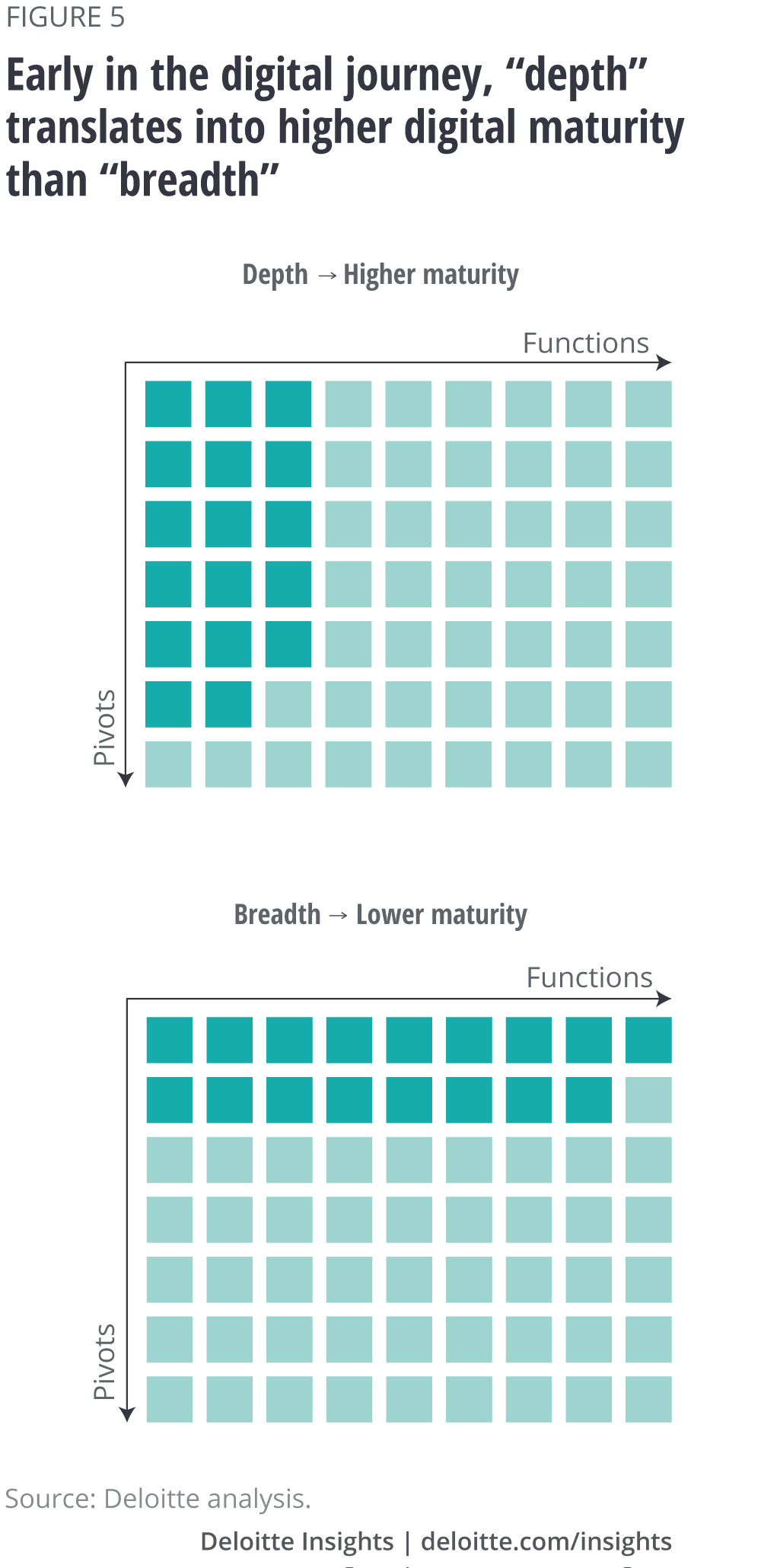
The survey provides support for the idea that companies are better off concentrating early efforts to implement pivots in one or two functions rather than spreading those efforts across many functions (figure 5). While digital maturity tends to be correlated with the level of effort, we found some respondents at the lower end of the effort spectrum were at the higher end of the digital maturity spectrum. These companies tended to execute twice as many pivots per function on average than their lower-maturity peers, who spread their efforts out across business functions.6 Early on in a company’s digital journey, it pays to go deep rather than broad.
Which functions should I start with?
So where should an organization begin? While customer and market-facing functions are critical, our experience suggests that starting with a back-office functional area such as finance, HR, or R&D can help an organization build confidence and digital skills at lower risk. As explored in previous Deloitte research, efforts to transform the “heart of the business” are critical precursors to front-office transformation.7 And the benefits from transforming back-office functions can be meaningful; significant efficiency gains and operational benefits can be achieved by transforming them. An organization can then apply the learnings from a back-office functional transformation to market-facing functions such as marketing, customer operations, or sales. Being able to show that digital transformation efforts are generating top-line impact can build additional enthusiasm and momentum.
Apply the remaining pivots next
With a function targeted for systemic transformation, an organization can undertake to apply the full complement of digital pivots (as relevant), described below, to that function.
Engaging with the ecosystem can accelerate innovation
A pivot strongly associated with higher levels of digital maturity is ecosystem engagement, which involves working with external business partners that may include R&D organizations, technology incubators, and startup companies to gain access to resources such as technology, intellectual property, or people to increase the organization’s ability to improve, innovate, and grow. Lower-maturity companies tend not to engage as effectively with external resources. Just 16 percent of these organizations strongly agreed with the statement that engaging with external business partners was making a significant positive impact on their business, compared to some 85 percent of higher-maturity organizations.
Intelligent workflows can unlock new opportunities
The intelligent workflows pivot entails implementing and continuously recalibrating processes to make the most of both human and technological capabilities. The idea is to pair people with technology to produce better outcomes instead of letting them deliver on their own. This pivot calls for streamlining core processes and workflows, using automation (such as robotic process automation [RPA]) to perform repetitive tasks, and supporting staff with artificial intelligence-powered tools. One payoff that doesn’t get enough attention: freeing up people to focus on higher-value tasks. Although data suggests that adoption of intelligent workflows is more common among higher-maturity organizations—70 percent of which are making significant use of it compared to just 13 percent of lower-maturity organizations8—companies do not have to wait to act on this until they are more advanced in their digital transformation journey. Technologies such as RPA are ripe for exploration and can deliver quick wins.
Excellent customer experience is a hallmark of digital maturity
Executing the unified customer experience pivot means delivering a seamless customer experience built around a 360-degree view of customer activities accessible across the organization so that customers experience coordinated digital and human interactions that are useful, enjoyable, and efficient in immersive, engaging environments. This can require breaking down data and operational silos to gain a comprehensive view of the customer and may involve exploring new digital interaction technologies such as augmented reality or voice assistants. Organizations that treat each customer touchpoint as part of an experiential system are not just being responsive to customer expectations; they are also unlocking significant commercial benefits. Our survey found that 87 percent of higher-maturity organizations were experiencing a significant positive impact from this pivot versus just 17 percent of lower-maturity organizations. This impact can take many shapes and forms—from higher levels of customer engagement to more repeat sales.
Business model adaptability helps capitalize on new opportunities
Lastly, business model adaptability—the adoption of new business models to meet the demands of new and shifting markets—is a common goal of companies with digital aspirations. Higher-maturity companies are almost twice as likely as lower-maturity organizations to say they have digital business models.9 Examples include offering two-sided platforms or marketplaces, products as a service, or subscriptions for data or other digital content. This pivot typically requires the solid execution of foundational pivots: Digital business models such as subscriptions or products-as-a-service, for instance, may require a more flexible, secure infrastructure than legacy business models. They often have data at their core. And they may require new talent models. Product companies implementing service-based business models, for instance, often require sales and customer service skills that are new to the organization.
Beyond the digital pivots
As essential as the digital pivots are, organizations need more to fulfill their potential. This can be seen in the survey data as well. As shown in figure 6, most (59 percent) of the organizations that had executed the most pivot applications—meaning they had executed many digital pivots in many functions—were at only the median level of digital maturity. Conclusion: The pivots are necessary but not sufficient. Prior research has suggested that intangible factors such as leadership and culture are also critical to the success of digital transformation initiatives.10
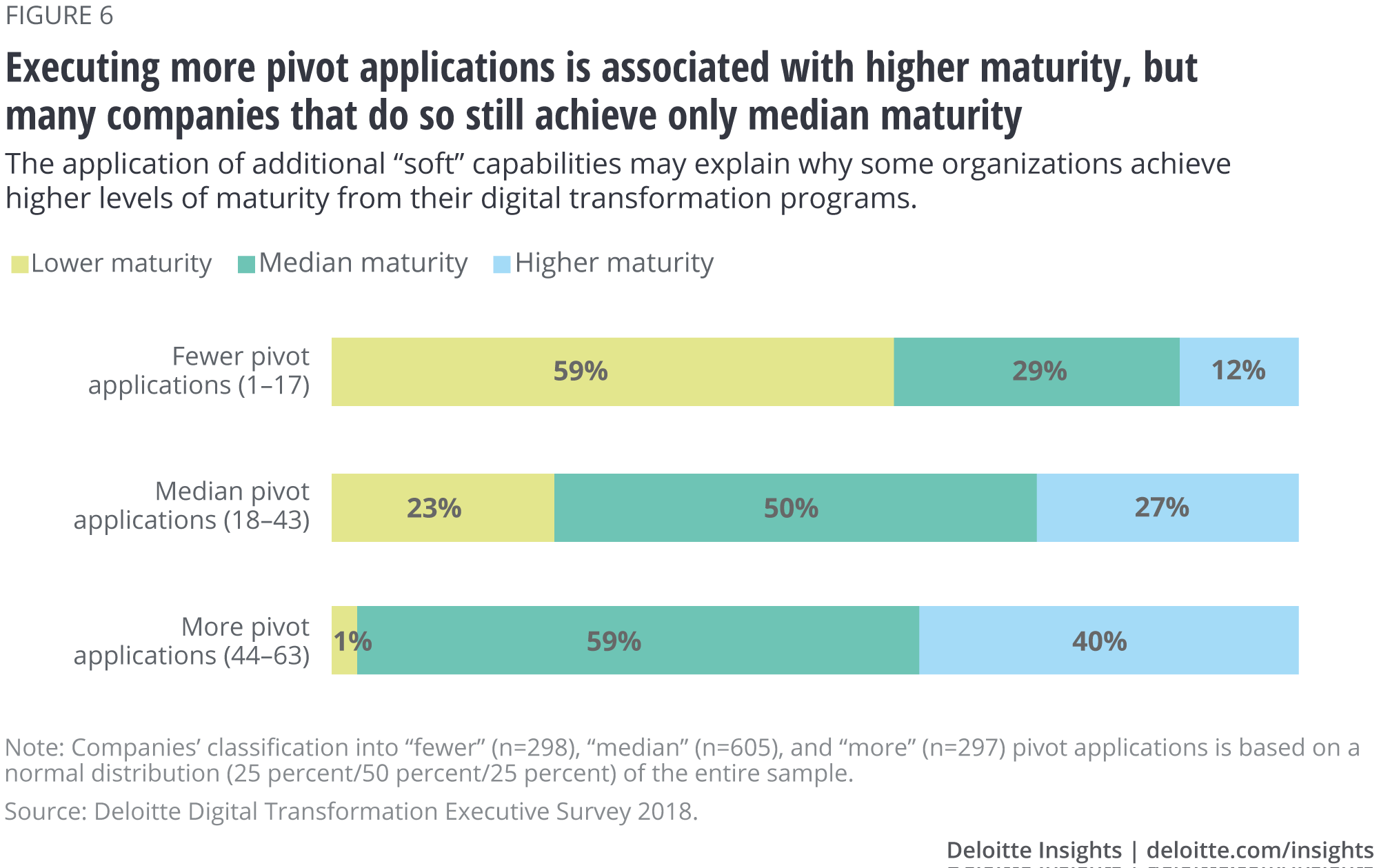
Leadership is key
Without the right leadership, digital transformation efforts tend not to fulfill their potential. Digital transformation requires executive sponsorship and engagement to both convey the message that digital transformation is a priority and facilitate collaboration throughout the organization. Functional leaders and teams cannot drive effective transformation without support from the organization’s leadership. All respondents in our survey cited strong leadership as a top tactic for overcoming challenges associated with digital transformation. Respondents at higher- and median-maturity companies were significantly more likely to do so than those at lower-maturity companies (62 percent and 59 percent vs. 45 percent) (figure 7).
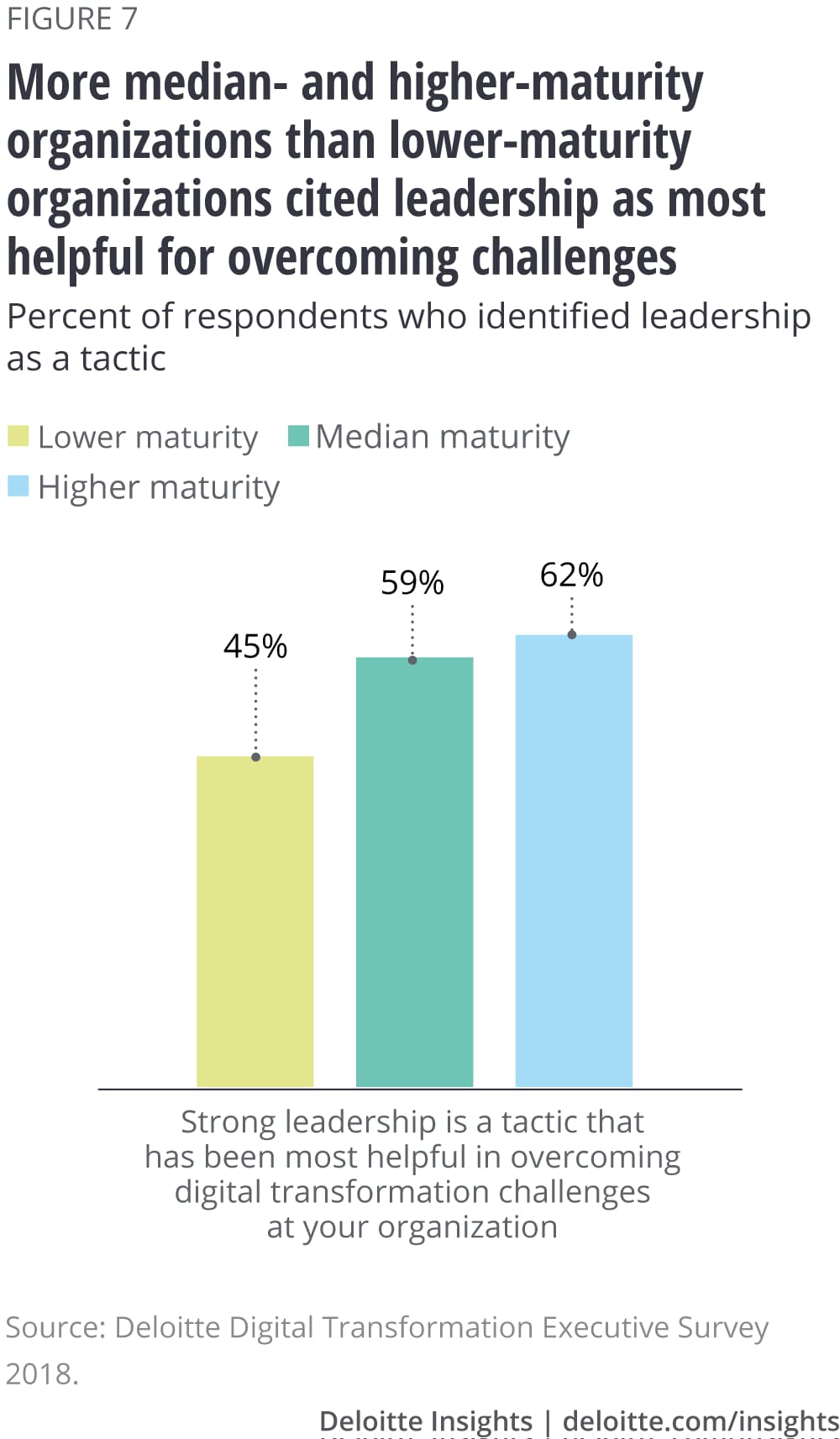
A digital mindset encourages digital behaviors
Another organizational attribute that can help translate transformation effort into impact is a “digital mindset,” which encourages the habit of looking at old problems and processes through new eyes and approaching them in new ways. Organizations can help cultivate a digital mindset by encouraging a culture of experimentation and enabling people throughout the organization to both challenge and improve upon best practices. According to the survey, higher-maturity organizations are nearly four times more likely than low-maturity companies to strongly agree that their organization and incentives encourage smart risk-taking to innovate and grow (figure 8).
For useful perspectives on digital leadership and culture, see “Coming of age digitally: Learning and leading in new ways.”11
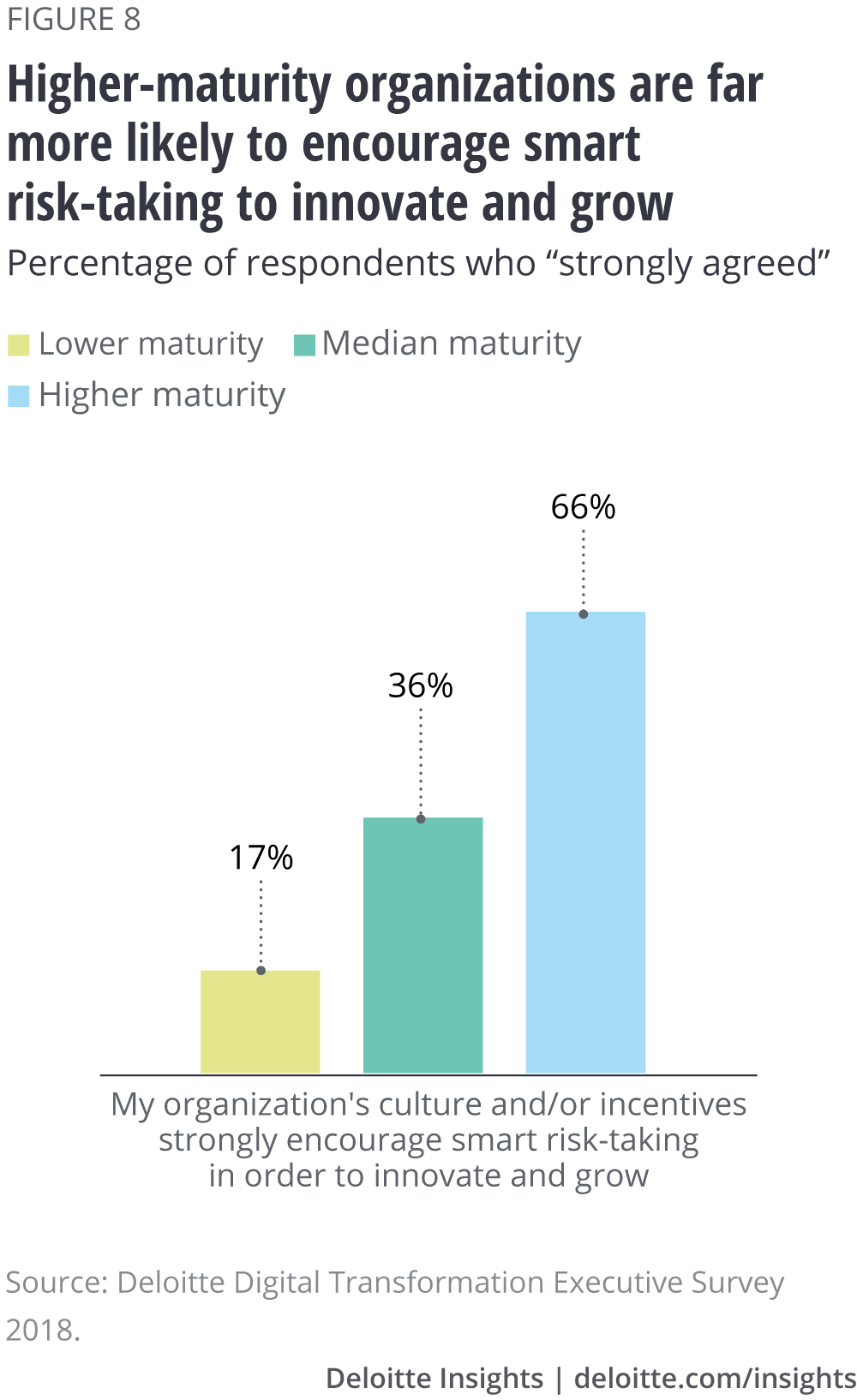
Facing challenges
Organizations undergoing digital transformation encounter multiple challenges. Many companies, for instance, find that their current operating model, even if it has served them well in the past, is a barrier. Executing the pivots broadly requires cross-functional coordination and the development and shared use of assets such as technology platforms, which may not be well supported in some operating models. In our survey, an ill-suited operating model/structure was the most widely cited challenge (figure 9).
Many companies find their digital ambitions are hampered by a lack of focus, leadership attention and funding. Often, they struggle to acquire or develop talent with the necessary skills; using flexible talent models requires changes that are difficult for some companies. Prioritizing transformation efforts is also often a big challenge—understandably so, given the breadth of the changes and size of the investment required. This is why we have highlighted a prioritization approach here.
Some 40 percent of respondents cited “upgrading legacy systems/processes” as a top-three challenge to digital transformation. This is no surprise: All organizations face the need to upgrade their information systems and evolve their business processes from time to time, and the usual challenges involved in systems integration, business analysis, and change management are familiar to many. However, digital transformation programs tend to bring these issues to the forefront, particularly when executing pivots such as intelligent workflows and unified customer experience.
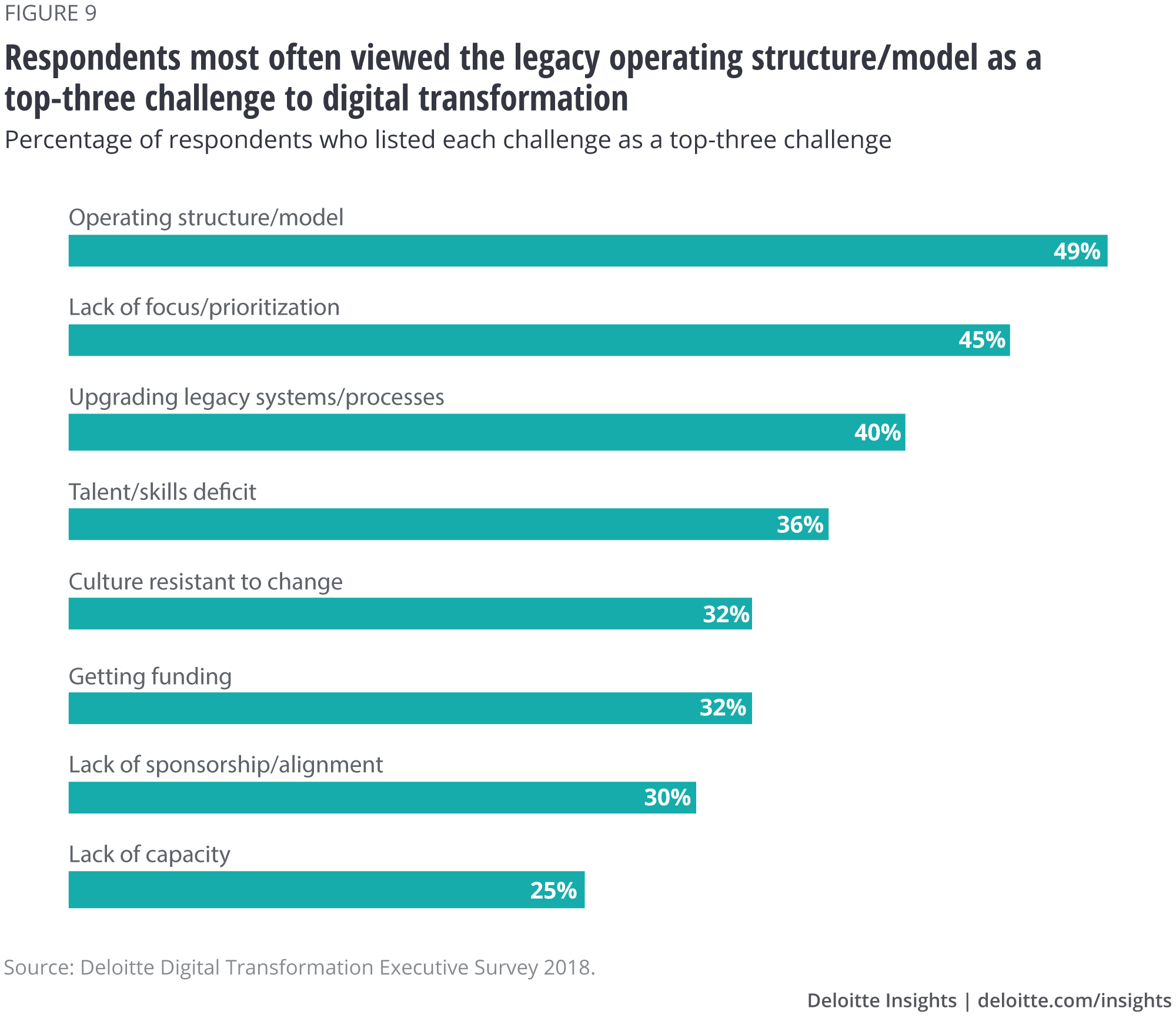
How do companies get past these challenges? Respondents at higher- and median-maturity companies tend to believe certain tactics are most helpful. These include strong leadership (noted above) and a consistent digital vision; establishing dedicated funding for transformation programs; and creating a distinct digital organization/function (figure 10).
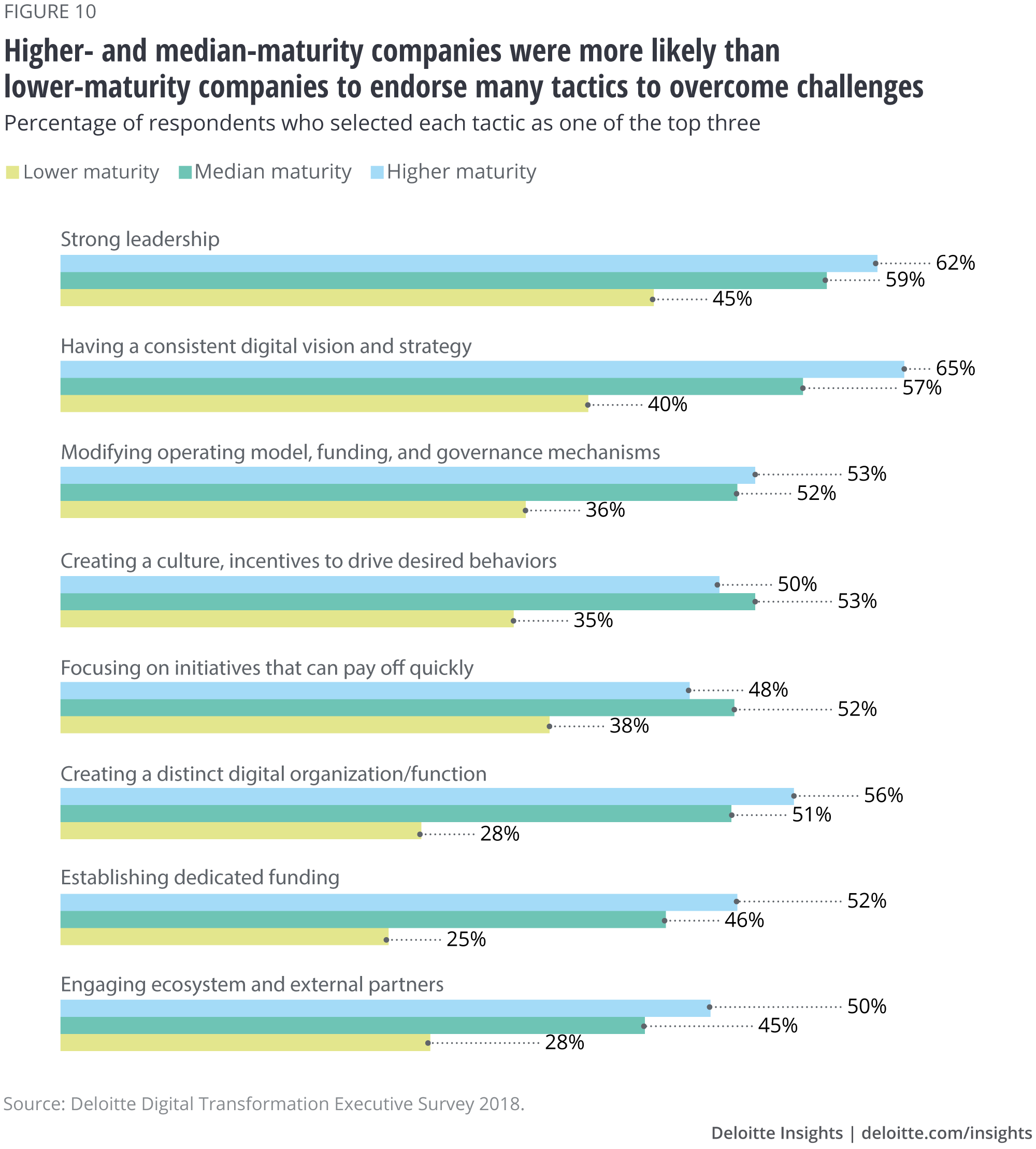
The benefits: Digital maturity drives financial impact
A key fact motivates some leaders’ commitment to digital transformation: a higher level of digital maturity is associated with better financial performance. About half of our surveyed higher-maturity organizations reported that their net profit margin and revenues were significantly above the average in their industry, compared to 17 and 19 percent respectively of lower-maturity organizations (figure 11).12 We believe this is due in large part to how the digital pivots enable digitally mature organizations to identify and seize new opportunities, develop new revenue streams, respond with more agility to customers and market demands, and operate with greater efficiency.
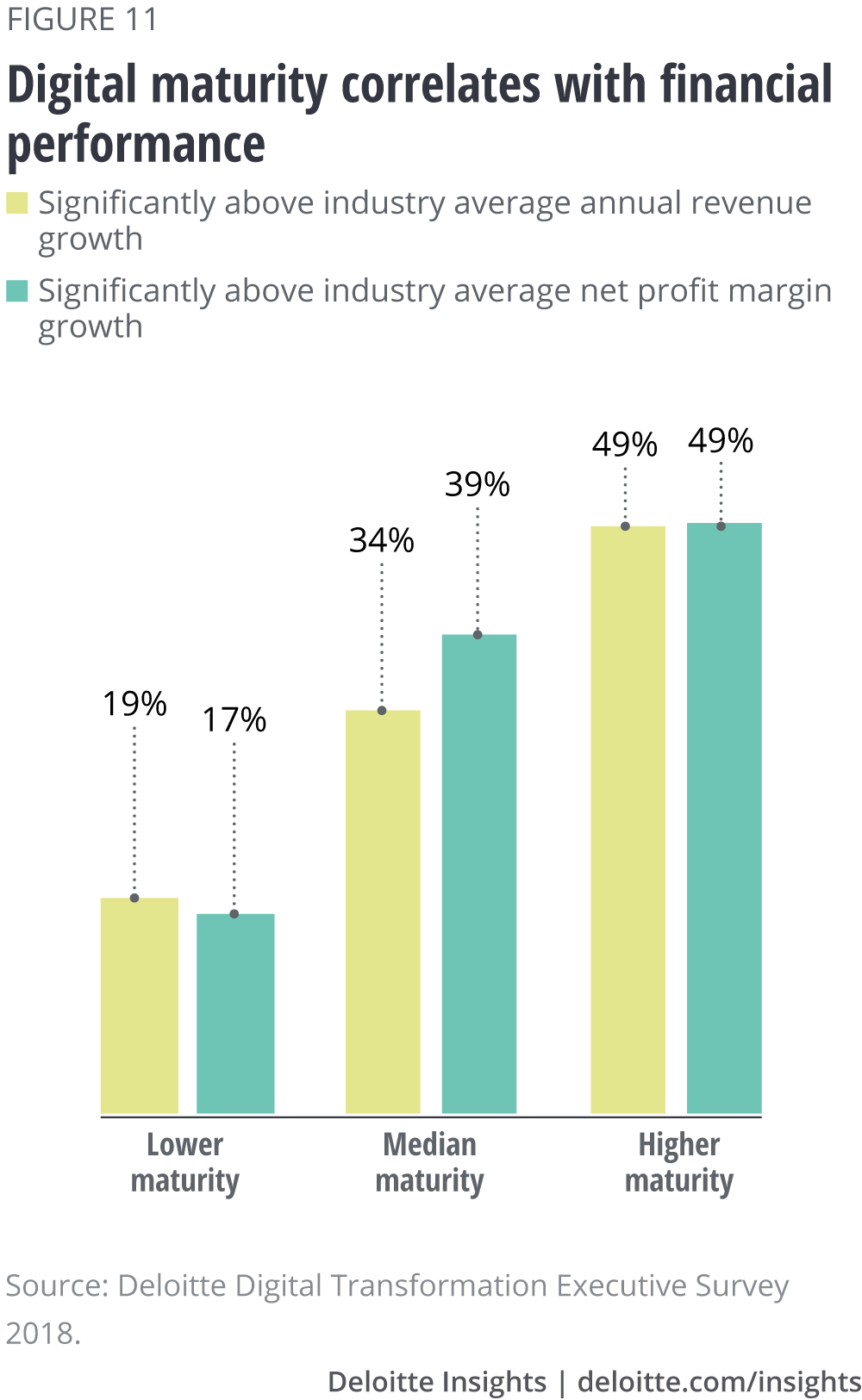
Digital transformation investments are slated to rise sharply
Estimates of how much companies spend on digital transformation are imprecise because there are no standards to distinguish between digital transformation investments and "ordinary" IT spending. But investments in digital transformation are robust and growing vigorously. Market researcher IDC has projected that spending on digital transformation globally will reach nearly US$2 trillion in 2022, achieving a five-year compound annual growth rate of 16.7 percent.13
Survey respondents’ organizations invested around o.6 percent of their revenues in digital transformation in 2018. In light of a prior Deloitte analysis showing that IT budgets accounted for about 3.3 percent of revenues,14 digital transformation could account for close to 20 percent of IT spending at some companies.
Moreover, companies plan to increase this spending significantly in 2019, with an average increase among our survey respondents of 25 percent over the prior year. More than half plan to spend more than US$10 million, while the share of those who plan to spend over US$20 million will double from 10 percent to 19 percent (figure 12). Company leaders may want to benchmark their own digital transformation spending against these figures and other sources to ensure they are investing at a level appropriate to their competitive environment and aspirations.
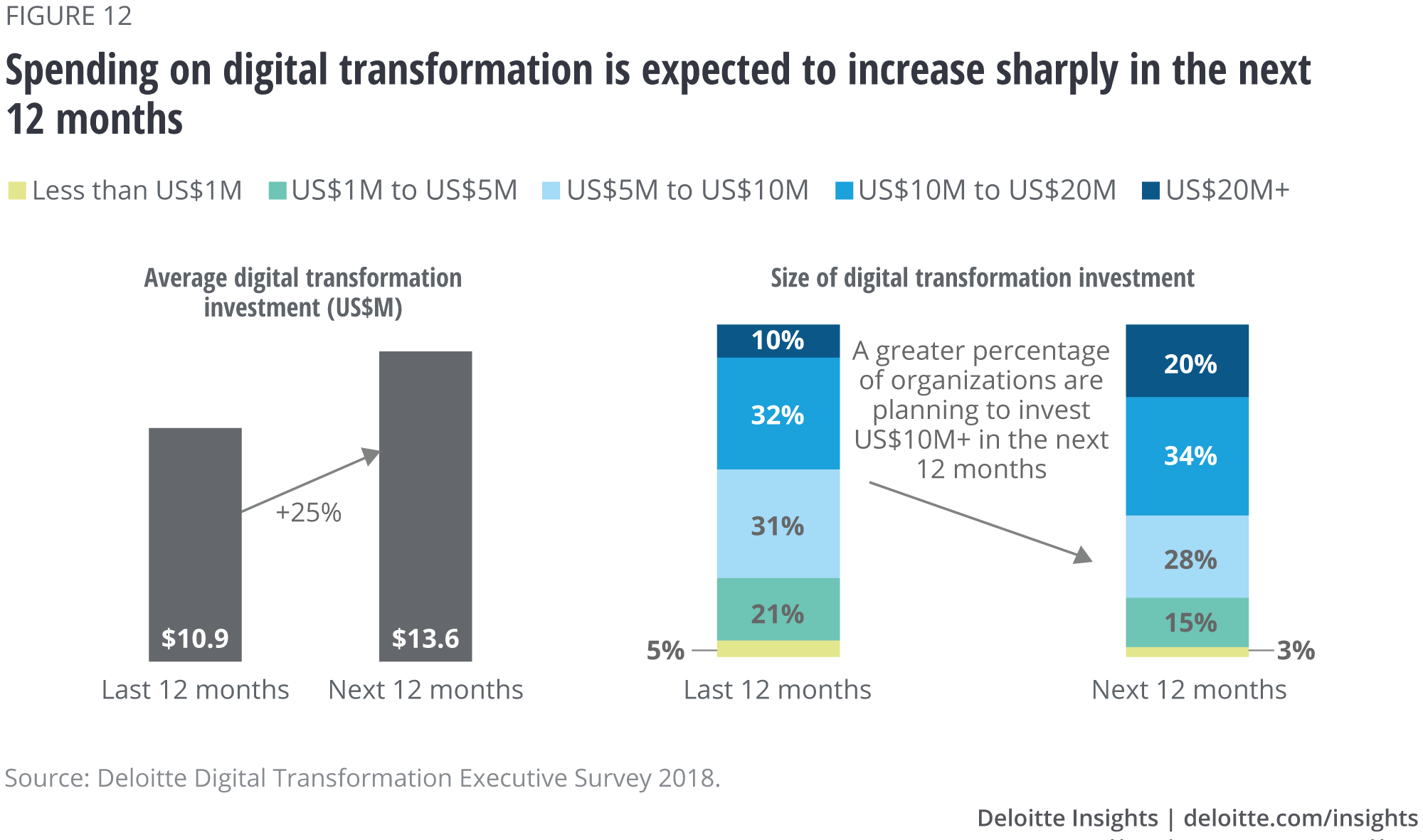
Continually becoming a digital enterprise
Digital transformation is a journey toward becoming a digital enterprise. This is not a fixed destination: A digital enterprise is continually evolving, always seeking to take full advantage of new technologies to innovate what it offers, how it sells and delivers, and how it operates. Digital maturity, consequently, isn’t an endpoint. It is the evolving capacity to reap the benefits of being a digital enterprise.
Executing the seven digital pivots is a way to realize greater business benefits—including stronger financial performance. Our research shows that greater benefits accrue to companies that execute more of the pivots more broadly across their organizations. We believe that maximizing the potential of digital transformation may require executing all of them, in concert.
Organizations cannot do everything at once, of course. There are commonsense ways to prioritize digital transformation efforts, which we have highlighted earlier. Leaders need to determine what path forward best suits their situation. The prize of progressing on that journey is often better financial results and greater strategic resilience in a rapidly changing world.
Appendix A: Methodology and demographics
This report draws upon insights gleaned from a survey conducted in November 2018, which asked 1,200 US-based executives to assess their organization’s approach to digital transformation. The respondents included in our analysis were those who reported that they were somewhat or highly knowledgeable about their organization’s digital transformation efforts, and who were from organizations of at least 500 people and US$250 million in annual global revenue. This sample included an equal number of respondents (200) from each of the following industries:
- Consumer products and services
- Energy, resources, and industrials
- Financial services and insurance
- Government and public services
- Life sciences and health care
- Technology, media and entertainment, and telecommunications
Seventy-four percent had C-level titles; the rest were VP or director level or equivalent. For greater accuracy, our analysis in this report excludes investment and financial performance data from government and public services respondents, which tended to be outliers.
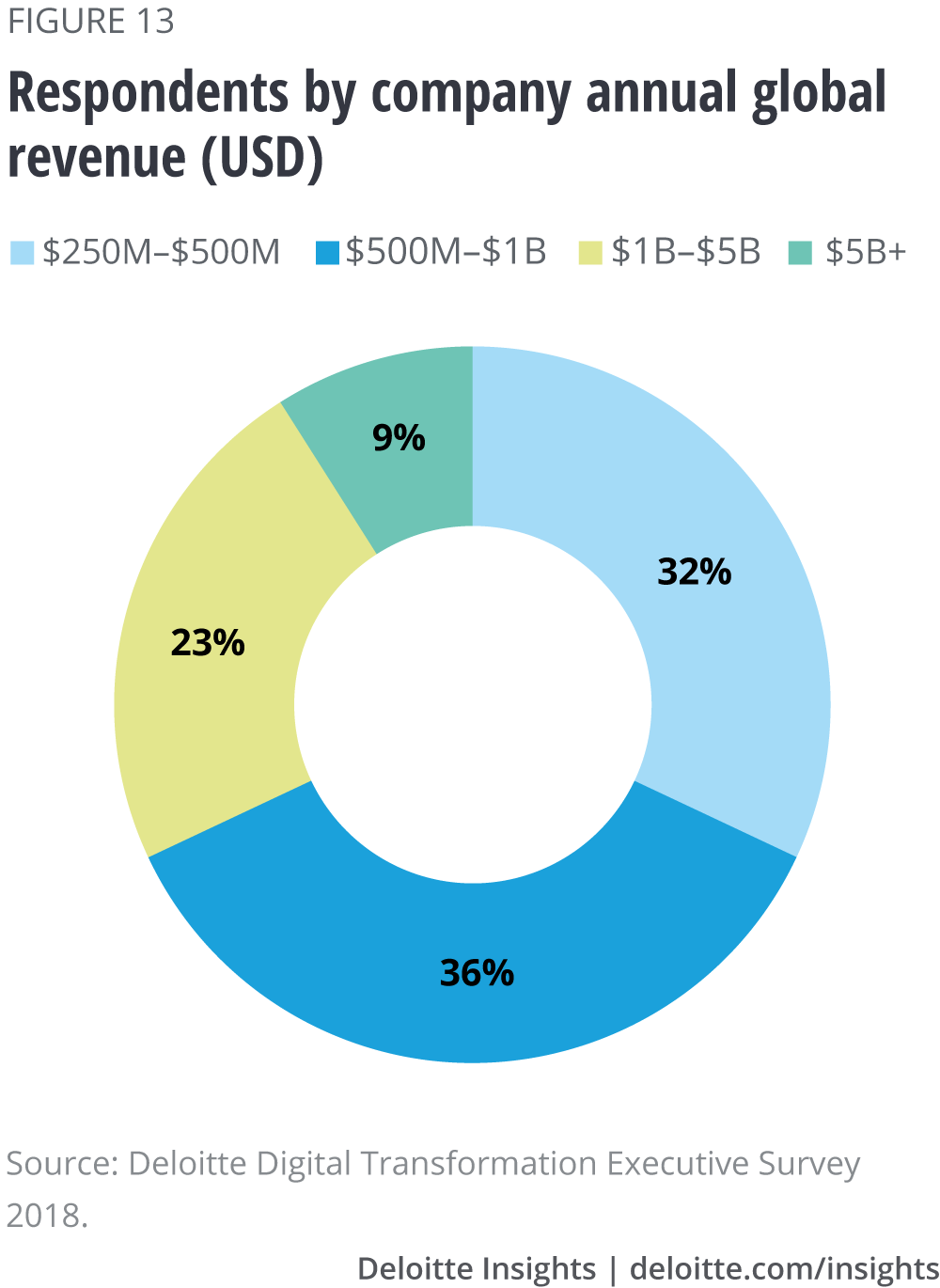
Modeling digital maturity
A portion of the survey asked respondents about their adoption of the digital pivots. For each pivot, they were asked about:
- The degree of effort invested in executing the pivot, on a five-point scale
- The breadth of their efforts to apply the pivot, calculated as the number of business functions to which the digital pivot has been applied. (Respondents were asked to select up to nine business functions to which the pivot applied; the more they selected, the greater the breadth.)
- Their use of tools and approaches of the pivot
- The degree of impact of the on the business, on a five-point scale
Because we believe the purpose of digital transformation is to create business impact, we took the aggregate business impact of all pivots, captured in the fourth of the above set of questions, as our measure of digital maturity.
Based on each organization’s responses to question 4 for all seven digital pivots, organizations were classified according to a normal distribution. Firms that scored in the top 25 percent were classified as “higher maturity,” those in the middle 50 percent were classified as “median maturity,” and those in the bottom 25 percent were classified as “lower maturity” (figure 2).
Appendix B: More about the digital pivots
Flexible, secure infrastructure
Companies across industries, including consumer products, insurance, and technology, are using public cloud infrastructures to help them further their digital transformations and tap cloud-based artificial intelligence technology platforms.15 Enterprise technology providers have made acquisitions to bolster their cloud and cybersecurity offerings and make it easier for clients to access and use them.16 The implementation of cloud-based infrastructure is having tangible impacts—allowing companies to, for example, deliver better customer experiences, reduce time to launch new products, and lower costs.17
Data mastery
Using data and analytics to uncover new business-relevant insights is becoming commonplace, helping companies find new efficiencies and opportunities. Some health care and financial services companies are forming new divisions dedicated to improving their data and analytics maturity.18 Consumer products companies are using e-commerce marketplace data on shoppers’ preferences to speed up product development cycles.19 An auto giant is working to analyze images with machine learning to accelerate quality control processes in its manufacturing plants.20 And a major investment bank is experimenting with how machine learning can help its financial advisors better manage clients’ money.21
Digitally savvy, open talent networks
Companies are working to develop new talent pools and increase their workforces’ digital savvy. Retail and logistics organizations are experimenting with crowdsourcing models to lower costs and increase operational flexibility.22 A major bank is using new collaboration tools to foster a more agile workplace culture, and an auto giant is offering bounties to cybersecurity researchers to help find vulnerabilities in its software.23
Ecosystem engagement
Partner ecosystems are helping companies across industries experiment with new technologies and drive transformation. Examples include companies in multiple industries (including financial services, logistics, and energy) creating or joining blockchain consortia, auto companies partnering with technology giants to offer new services, and telecom competitors pooling their cybersecurity resources.24
Intelligent workflows
The push to make operations more efficient driving increased interest and investment in technologies that automate tasks and processes to save time and costs. Companies in retail and logistics are deploying robots to automate routine tasks, while technology companies are integrating robotic process automation (RPA) into their enterprise software and services to streamline workflows.25
Due to rapidly advancing technological capabilities, the ability to automate tasks within an organization has never been greater. To maximize impact, organizations must balance and continuously recalibrate the benefits and drawbacks of automation approaches across the spectrum from fully manual through human-in-the-loop to fully automated to arrive most efficiently and effectively at the desired outcomes.
Unified customer experience
Starting in the consumer market and expanding into the B2B market, digital organizations have familiarized us with exceptional, seamless, and holistic customer experiences, causing customer expectations for every commercial interaction—irrespective of industry or context—to rise.
Unsurprisingly, the retail industry has led the charge in heightening customer expectations, seamlessly blending physical and digital channels. For example, a major retailer is using virtual and augmented reality to enhance in-store shopping experiences.26 Voice assistants and chatbots are helping to create new interactive experiences in industries beyond retail, including banking, and transportation.27 Other examples of customer experience innovation include a major hospitality chain partnering with technology companies to create new experiences for guests by analyzing customers’ profile data and preferences.28
Business model adaptability
The pace of marketplace change has never been greater, which means organizations must prioritize adaptability to thrive—including adaptability in their business models. By adopting a variety of different business models that rely on digital technologies, digitally maturing companies are taking advantage of new revenue opportunities. A major pharmacy chain bought a stake in an online beauty subscription service to help create new digital experiences within its store locations and grow its e-commerce presence.29 An insurance conglomerate acquired an IoT software startup to develop new data and risk management solutions for industrial clients.30 And auto manufacturers have started offering new subscription services to experiment with services and establish recurring revenue streams.31
Appendix C: Digital maturity by industry
Some industries tend to be more digitally mature overall than others. This is largely a function of the actions taken (or not taken) by the players in that industry, often in response to competitive challenges influenced by potential technological disruptions. Our study found that a greater percentage of respondents in technology, media, and telecommunications (TMT) companies came from higher-maturity organizations, while respondents from life sciences and health care companies were three times as likely to work at lower-maturity organizations than higher-maturity ones (figure 14).
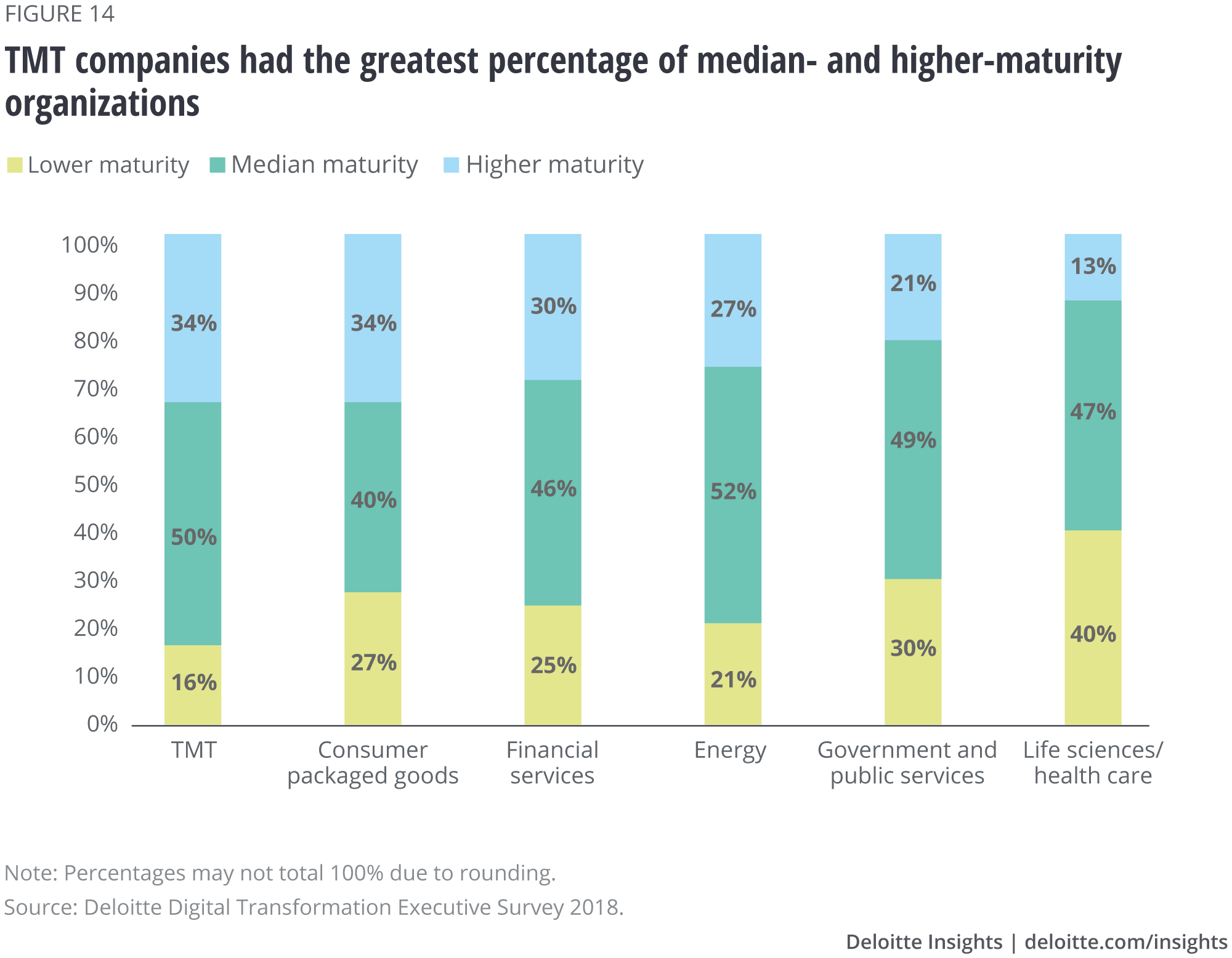
© 2021. See Terms of Use for more information.
Explore more of the Digital transformation collection
-
Tech Trends 2025 Article4 months ago
-
Innovation in Europe Article6 years ago
-
Bringing digital to the boardroom Article6 years ago
-
The new frontier Article6 years ago
-
The new core Article7 years ago












